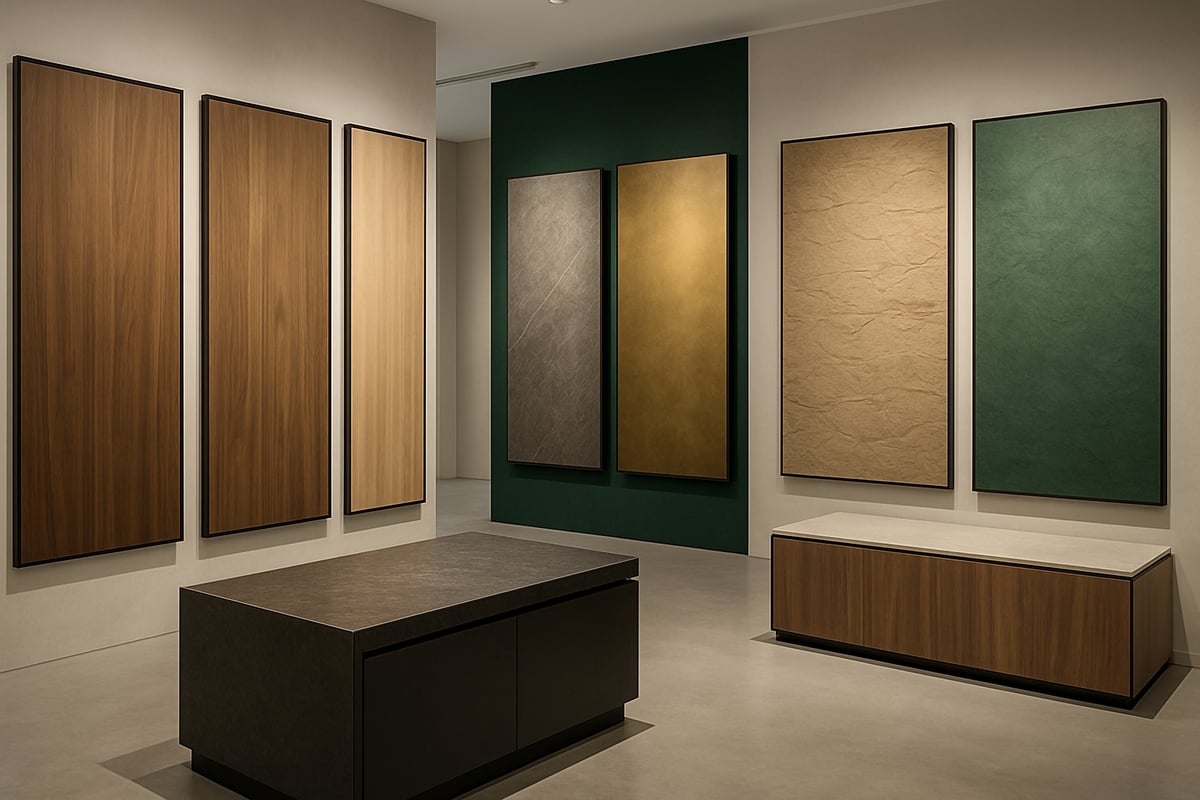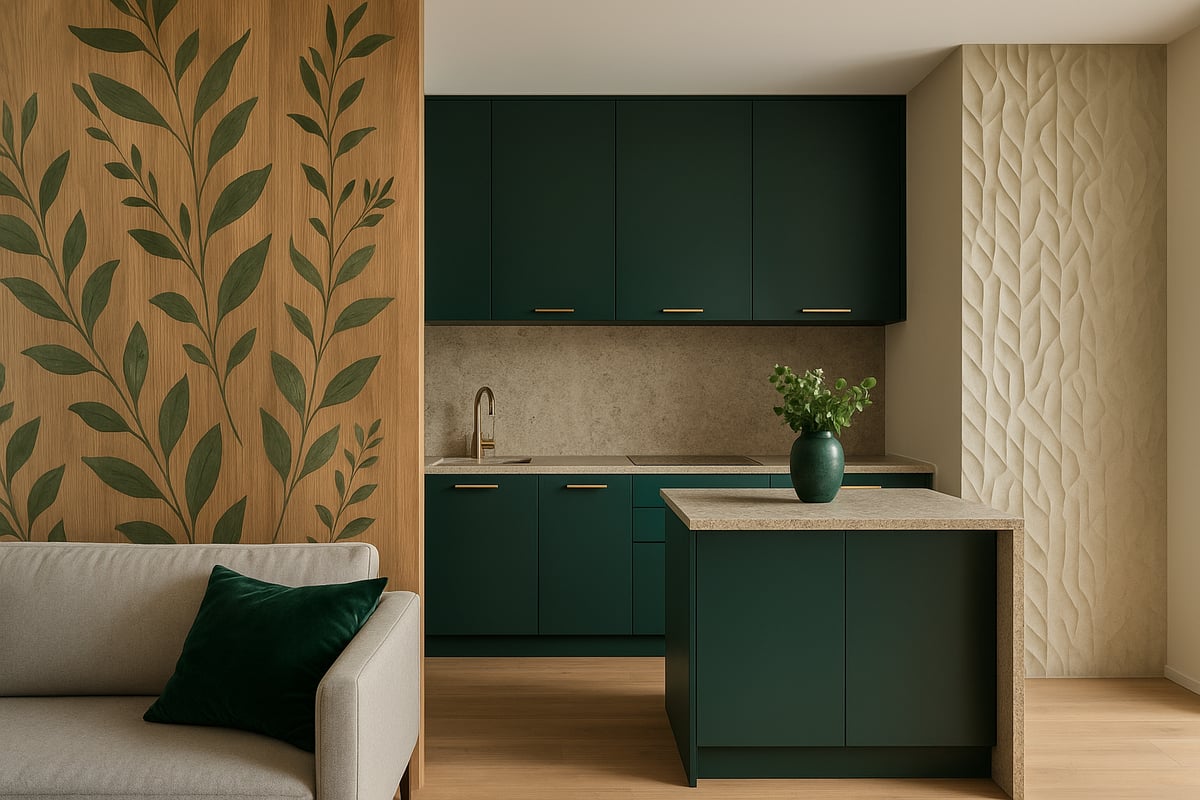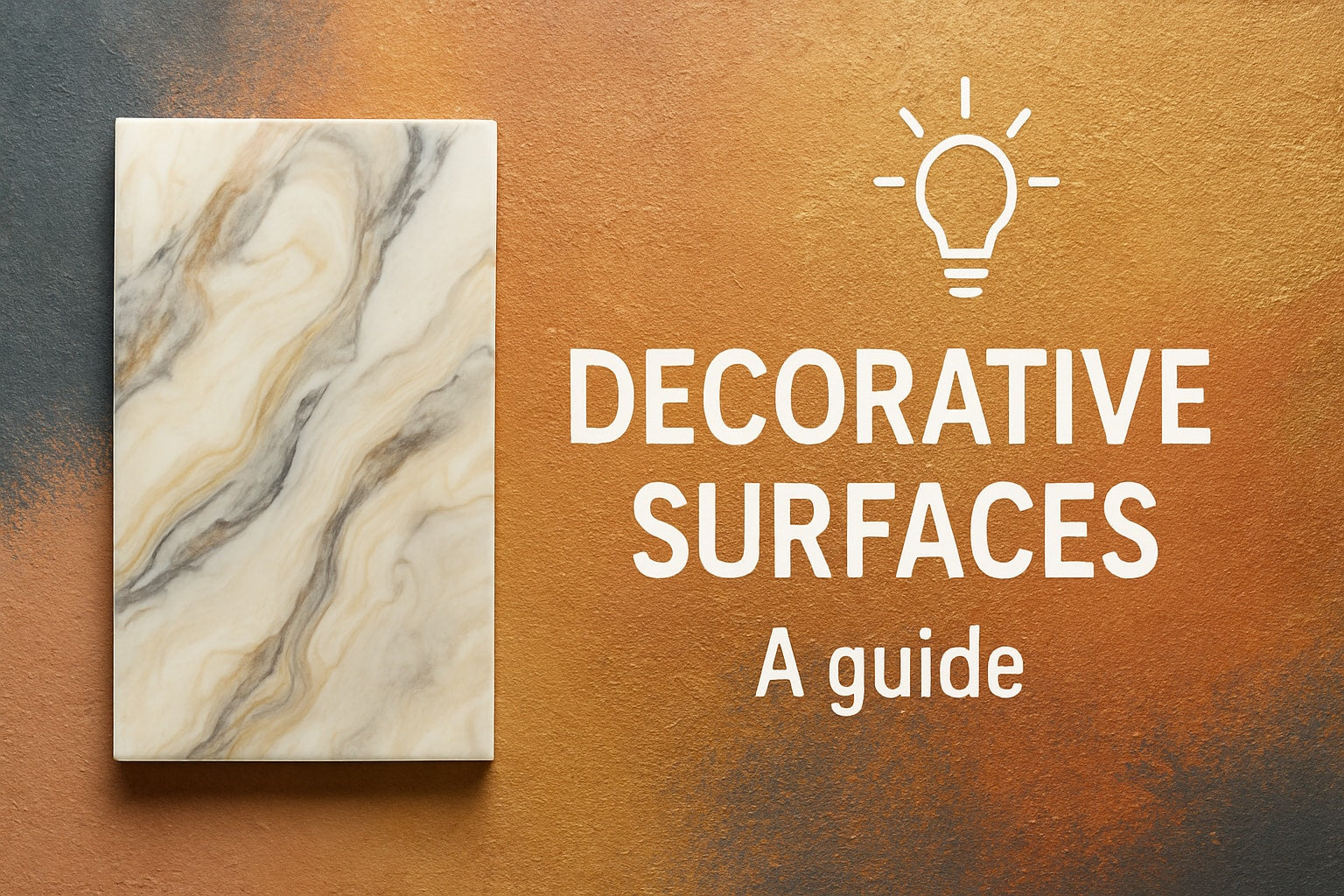Imagine walking into a space that instantly feels inviting and unique. The secret often lies in the choice of decorative surfaces, which can completely redefine the atmosphere of any room.
In 2025, the world of interior design is evolving rapidly. Decorative surfaces are now essential for both style and functionality in modern homes and businesses. They set the tone, reflect personality, and offer limitless creative potential.
Curious how you can harness these innovations? This guide reveals the latest trends, practical tips, and expert advice to help you choose, apply, and maintain decorative surfaces that transform your space.
Get ready to explore trending materials, design directions, sustainability solutions, and insider recommendations for every project.
Understanding Decorative Surfaces: Definitions and Importance
Decorative surfaces have become an essential element in shaping the look and feel of modern interiors. Their versatility and visual appeal influence how any space is experienced, whether in a home, office, or commercial setting. Understanding the fundamentals of decorative surfaces helps in making informed design decisions that reflect both style and function.

What Are Decorative Surfaces?
Decorative surfaces are materials applied to visible areas of interiors to enhance aesthetics and atmosphere. Unlike structural elements, these surfaces focus on appearance, texture, and finish rather than supporting weight or integrity. Common materials include laminates, veneers, acrylics, stone, metal, and glass.
You will find decorative surfaces on walls, furniture, cabinetry, and even ceilings. For example, a kitchen might feature high-gloss acrylic cabinets, while an office lobby uses stone veneer panels. By influencing light, texture, and color, decorative surfaces set the tone and perception of a space.
Why Decorative Surfaces Matter in 2025
In 2025, decorative surfaces are more important than ever due to a shift toward personal expression and unique design. Consumers increasingly seek materials that reflect their personality or brand identity, making surfaces a core aspect of both residential and commercial interiors.
Surface finishes now play a critical role in property value and market appeal. Recent industry surveys show that 67 percent of designers view decorative surfaces as a key element in their 2024-2025 projects. For a deeper dive into upcoming innovations, the 2025 Decorative Surface Trends Guide offers valuable insights on what to expect this year.
Key Benefits of Modern Decorative Surfaces
Modern decorative surfaces deliver significant advantages over traditional finishes. They offer impressive durability and are easy to maintain, making them suitable for high-traffic or challenging environments. Their versatility allows for creative design solutions and simplified installation processes.
Cost-effective alternatives, such as faux stone or engineered veneers, allow designers to achieve high-end looks without the associated expense. Many decorative surfaces now provide enhanced acoustic and thermal performance. Technological advancements have introduced anti-microbial, scratch-resistant, and eco-friendly options, further increasing their appeal.
Types of Decorative Surfaces: A Quick Overview
There is a wide range of decorative surfaces available, each suited to specific applications and design goals. Here is a quick comparison:
| Type | Description / Example |
|---|---|
| Laminate Sheets | HPL, CPL, thermoplastic, easy to clean |
| Veneers | Natural, engineered, reconstituted |
| Acrylic Panels | Glossy, matte, textured finishes |
| Faux Stone/Brick Panels | Lightweight, realistic, easy to install |
| Metallic/Glass/3D Wood | Modern mosaics, metallics, sculpted wood |
With so many options, decorative surfaces can be tailored to match any style, from minimalist to bold and expressive. Their adaptability is a driving force in the evolution of interior design.
Top Decorative Surface Trends for 2025
As we move into 2025, the landscape of decorative surfaces is evolving rapidly, with designers and homeowners seeking innovative ways to enhance both aesthetics and functionality. The following trends capture the leading directions shaping interiors this year, from nature-inspired motifs to advanced technological features. Each trend reflects a growing demand for personalization, sustainability, and creative expression in decorative surfaces.

Biophilic and Nature-Inspired Designs
Biophilic design is at the forefront of decorative surfaces for 2025. This trend brings the outdoors inside through materials and patterns that echo the natural world. Expect to see wood veneers, stone textures, and botanical motifs used in creative ways on walls, cabinetry, and ceilings. Organic patterns and earthy color palettes are in high demand, with faux stone panels in terracotta hues and reclaimed wood finishes gaining popularity. According to industry reports, there has been a 54 percent increase in nature-inspired decorative surfaces in 2024. For inspiration, explore Biophilic Interior Design Inspiration to discover how this trend can elevate your space.
Sustainable and Eco-Friendly Materials
Sustainability is now a core criterion in selecting decorative surfaces. Homeowners and designers are gravitating toward recycled, reclaimed, and rapidly renewable materials. Certifications such as FSC, Greenguard, and LEED are increasingly sought after, ensuring responsible sourcing and healthier indoor air. Low-VOC and non-toxic finishes are not just preferred but often expected. Popular examples include sustainably harvested wood veneer sheets and recycled glass mosaics. Market data shows that 72 percent of consumers now prioritize sustainability when choosing decorative surfaces, marking a decisive shift toward eco-conscious design.
Bold Colors and Metallic Accents
Decorative surfaces in 2025 are embracing color in bold new ways. Vibrant hues, jewel tones, and color-blocking techniques are making a statement in both residential and commercial spaces. Rich combinations like navy and gold or emerald and brass are particularly prominent, adding luxury and depth. Metallic laminates, high-gloss finishes, and reflective surfaces are being used to create focal points and enhance lighting. For example, MetLam metallic high-pressure laminates deliver a sophisticated sheen, making them a favorite for feature walls and statement furniture. This trend redefines how decorative surfaces contribute to a room's personality.
Textured and 3D Surfaces
Tactile finishes are taking center stage as decorative surfaces move beyond flatness. Expect to see ribbed, fluted, and embossed panels that invite touch and add dimension to interiors. 3D wood panels and acoustic wall solutions are popular for their ability to blend visual interest with functional benefits like sound management. FlexLam thermoplastic wall panels with geometric patterns are a standout choice, offering flexibility and durability. These textured decorative surfaces are ideal for accent walls, ceilings, and creative installations, turning ordinary spaces into dynamic environments.
Smart and Functional Surfaces
Technological innovation is transforming decorative surfaces into multi-functional elements. Anti-microbial, stain-resistant, and self-healing technologies are becoming standard, especially in high-traffic and healthcare settings. Decorative surfaces now often incorporate integrated lighting or interactive features, merging form and function. Multi-functional wall panels are gaining traction in both homes and offices, offering storage, sound absorption, and display options. This trend ensures that decorative surfaces do more than look good—they actively contribute to the usability and safety of interior spaces.
Peel-and-Stick and DIY-Friendly Options
Ease of installation is a major driver behind the popularity of peel-and-stick decorative surfaces. These products cater to renters, DIYers, and anyone seeking a quick transformation without major renovations. Peel-and-stick options now include wood, brick, and stone aesthetics, allowing for creative freedom and customization. Anaglypta paintable wallpaper is a prime example, offering a textured base that can be finished in any color to suit personal style. As a result, decorative surfaces have become more accessible, empowering individuals to refresh their interiors with minimal effort.
Customization and Personalization
Personalized interiors are a defining feature of decorative surfaces in 2025. Advances in digital printing, modular design, and bespoke manufacturing enable homeowners and designers to create unique patterns and finishes. Custom-printed acrylic panels and mosaics allow for branding or one-of-a-kind statements in both residential and commercial spaces. Modular decorative surfaces make it easy to adapt to evolving tastes or functional needs. This trend underscores the growing expectation for interiors that reflect individual identity, making every space distinct and memorable.
Choosing the Right Decorative Surface: Practical Tips and Considerations
Selecting the best decorative surfaces for your project requires a thoughtful approach. By evaluating your space, materials, style, budget, and installation needs, you can ensure a cohesive and lasting result. Let us break down the process into clear steps for confident decision-making.

Assessing Project Needs and Space Usage
Before exploring materials, analyze how the space will be used. High-traffic areas, such as entryways or kitchens, require decorative surfaces that offer superior durability and resistance to wear.
Moisture-prone zones, like bathrooms, benefit from water-resistant options. For commercial spaces, prioritize surfaces that are easy to clean and maintain. If your project involves retail or hospitality, consider surfaces that can withstand frequent use while keeping their visual appeal.
To maximize the value of decorative surfaces, match their performance to your environment. For instance, a scratch-resistant panel is ideal for a busy retail store, while a matte acrylic may suit a tranquil office. Always align your choices with daily demands and long-term function.
Material Selection: Pros, Cons, and Best Uses
Understanding the strengths and limitations of decorative surfaces is crucial. Laminates are cost-effective and versatile, making them suitable for cabinetry and wall panels. Veneers provide a natural look but may require more care.
Acrylic panels are easy to clean and offer a modern finish, while faux stone or brick panels create texture without the weight of real materials. Consider the following table for a quick comparison:
| Material | Pros | Cons | Best Uses |
|---|---|---|---|
| Laminate | Affordable, durable | Limited texture | Cabinets, walls |
| Veneer | Natural appearance | Needs maintenance | Furniture, accents |
| Acrylic | Easy care, modern look | Prone to scratches | Kitchens, bathrooms |
| Faux Stone | Lightweight, realistic | Less authentic feel | Feature walls, exteriors |
For cabinetry, explore Stylish Cabinet Surface Solutions to find options that blend style and performance.
Style and Color Coordination
Decorative surfaces set the tone for your space, so align them with your overall design vision. Modern interiors often combine sleek laminates with bold acrylics, while rustic styles benefit from wood veneers and textured panels.
Mixing finishes and colors can create depth and interest, but balance is key. Avoid clashing patterns by choosing a dominant surface and supporting accents. Color psychology also plays a role; cool tones promote calm, while warm hues energize.
Digital tools, such as Easy 3D CAD for Surface Design, allow you to visualize combinations before committing. This approach ensures your decorative surfaces harmonize with furnishings and lighting.
Budgeting and Cost Factors
Cost is a significant factor when choosing decorative surfaces. Prices vary based on material, finish, and installation complexity. Laminates are generally more affordable, while natural veneers and specialty panels command higher prices.
To manage expenses, opt for faux materials or modular panels that mimic premium looks at a lower cost. DIY-friendly options, such as peel-and-stick surfaces, reduce labor fees. When renovating, consider the return on investment, as updated surfaces can boost property value and appeal.
Compare quotes from multiple suppliers and factor in long-term maintenance costs. A well-planned budget allows you to achieve your desired look without overspending.
Installation and Maintenance Tips
Proper installation ensures decorative surfaces deliver maximum performance. Decide whether to hire a professional or take the DIY route. Professionals bring expertise, especially for complex patterns or large spaces, while DIY options suit smaller projects.
Follow manufacturer guidelines for adhesive, cutting, and finishing. Regular cleaning with suitable products maintains appearance and extends lifespan. Surfaces like acrylic and laminate are low-maintenance, while veneers may require periodic sealing.
Avoid common mistakes, such as improper substrate preparation or using harsh chemicals. With the right approach, decorative surfaces will remain beautiful and functional for years.
Innovative Applications of Decorative Surfaces
Decorative surfaces are transforming the way we design and experience interiors today. From bold statement walls to subtle enhancements, these materials offer endless possibilities for both residential and commercial environments.
Innovative uses of decorative surfaces are not just about aesthetics, but also about adding value, function, and personality to any space. Let’s explore how these solutions are being leveraged for maximum impact in 2025.

Accent Walls and Feature Panels
Accent walls are a powerful way to introduce character and depth using decorative surfaces. Whether it is a living room, bedroom, or corporate lobby, feature panels can create a memorable focal point.
Popular options include 3D wood, acrylic, or mosaic panels, which add texture and visual intrigue. For example, FlexLam panels are frequently used in reception areas to convey sophistication and brand identity. According to Cosentino's 2025-2026 Global Trend Report, macro trends now emphasize sensorial experiences and tactile finishes, making accent walls a top choice for designers.
- 3D geometric patterns for visual interest
- Large-format acrylic sheets for seamless looks
- Mosaic tiles for color and pattern
Decorative surfaces on accent walls can also help define zones in open-plan layouts, combining style with spatial function.
Furniture and Cabinetry Upgrades
Upgrading furniture and cabinetry is another exciting application for decorative surfaces. Refacing cabinets with new veneers or laminates can instantly modernize kitchens, bathrooms, or office spaces.
Adding metallic or textured accents to furniture fronts is a cost-effective way to refresh interiors without a full remodel. Peel-and-stick products make it easy for DIYers to achieve professional-looking results. A case study from 2025 shows that outdated kitchen cabinetry can be dramatically transformed with adhesive decorative surfaces, offering both durability and contemporary style.
- Cabinet refacing with wood or acrylic sheets
- Metallic laminate overlays for drawers
- Textured vinyl wraps for desks and tables
These solutions allow for rapid updates, minimal downtime, and a personalized finish.
Ceilings and Vertical Spaces
Ceilings are often overlooked, yet decorative surfaces can turn them into standout features. Decorative ceiling tiles, acoustic panels, or geometric wall panels add dimension and help manage sound in busy spaces.
In open-plan layouts, ceiling treatments are used to visually separate zones, such as dining from living areas. Acoustic panels, for example, provide both aesthetic appeal and functional sound absorption, making them ideal for home theaters or offices.
- 3D ceiling tiles for added height and drama
- Acoustic wall panels for noise reduction
- Vertical wood slats to elongate small spaces
Decorative surfaces in vertical applications can also brighten rooms and create a cohesive design language throughout the property.
Commercial and Hospitality Design
In commercial and hospitality settings, decorative surfaces become vital for branding and durability. Custom-printed panels allow businesses to showcase logos, artwork, or unique color schemes, helping reinforce brand identity.
High-traffic areas such as hotel lobbies or retail stores benefit from easy-to-clean, scratch-resistant materials like glass mosaics or high-pressure laminates. For example, mirror glass mosaic sheets are often used in upscale hotel lobbies to add luxury and reflect light.
- Custom graphics for retail environments
- Durable laminates for restaurant walls
- Branded glass mosaics for hospitality entries
These solutions ensure that decorative surfaces stand up to daily wear while maintaining a high-end appearance.
Outdoor and Wet Area Solutions
Decorative surfaces are not limited to interiors. Weather-resistant faux stone and brick panels are increasingly used in outdoor kitchens, patios, and facades, offering the look of natural materials without the maintenance.
For wet areas like bathrooms, spas, and pools, waterproof acrylic panels provide both safety and style. Acrylic block casement panels are a popular choice for outdoor kitchens, combining resilience with a modern aesthetic.
- Waterproof panels for showers and pool surrounds
- Faux stone cladding for exterior walls
- Slip-resistant surfaces for patios
With the right decorative surfaces, even challenging environments can be elevated to new levels of beauty and function.
Sustainability and Future Directions in Decorative Surfaces
Sustainability has become a driving force in the evolution of decorative surfaces. As the industry moves into 2025, manufacturers, designers, and consumers are prioritizing eco-friendly practices and innovative technologies. The future of decorative surfaces rests on responsible sourcing, advanced manufacturing, and global influences that shape both style and substance.
Eco-Conscious Manufacturing and Sourcing
Eco-conscious manufacturing is transforming how decorative surfaces are produced and sourced. Brands now focus on recycled content, circular design, and material traceability to ensure their products meet rising sustainability standards. This includes using FSC-certified wood veneer sheets and rapidly renewable resources like bamboo. Many companies are also transparent about their supply chains, giving consumers confidence in their choices. As a result, decorative surfaces are not only stylish but also environmentally responsible, reflecting a growing demand for ethical design.
Technological Advancements
The integration of technology is accelerating the evolution of decorative surfaces. Smart surfaces with IoT capabilities, self-cleaning coatings, and advanced digital printing are now common features. Artificial Intelligence and CAD tools help customize patterns and optimize material usage, leading to unique and efficient outcomes. In 2024, 40% of new decorative surfaces launched included tech enhancements. These innovations increase performance, offering antimicrobial, scratch-resistant, and interactive options that meet the needs of modern interiors.
Lifecycle and End-of-Use Considerations
Sustainability does not end at installation. The full lifecycle of decorative surfaces is now under scrutiny. Designers and manufacturers are creating surfaces that can be recycled, upcycled, or designed for disassembly and reuse. This approach reduces waste and supports a circular economy. Consumers increasingly demand transparency about how products are made and what happens at the end of their life, which encourages brands to provide clear information on recyclability and responsible disposal.
Global Influences and Market Trends
Global trends are reshaping decorative surfaces, with regional preferences guiding both style and material choice. Asian minimalism, Mediterranean textures, and Scandinavian simplicity influence designs worldwide. The segment is projected to reach $40B by 2025, driven by changing consumer needs and supply chain shifts. Industry reports, such as the Interior Decorative Plaster Industry Performance 2025, highlight how decorative surfaces are adapting to regional and global demands, ensuring the industry remains dynamic and future-ready.
Expert Tips for Maximizing Decorative Surface Impact
Transforming your space with decorative surfaces is both an art and a science. By applying expert strategies, you can elevate interiors, extend surface life, and ensure your design remains timeless. Below, discover practical tips that help maximize the impact of decorative surfaces in any project.
Design Principles for Cohesive Surfaces
Achieving harmony with decorative surfaces starts with thoughtful composition. Begin by balancing striking statement pieces, such as bold wall panels or vibrant tiles, against subtle backgrounds. This prevents visual clutter and allows each element to shine.
Layering textures adds depth and interest. Combine smooth acrylics with ribbed wood or metallic finishes to create a tactile experience. Avoid overusing bold patterns in one room, as this can overwhelm the space. Instead, select one surface to lead, with others playing supportive roles.
Finally, ensure that decorative surfaces align with your overall design vision. Consider the scale, proportion, and color palette to tie everything together seamlessly.
Maintenance and Longevity Best Practices
Proper care extends the lifespan and beauty of decorative surfaces. Start with regular cleaning routines tailored to each material. For example, use gentle cleansers on acrylics and specialized products for wood veneers.
Protective treatments, such as sealants or scratch-resistant coatings, can help surfaces withstand daily wear. Address minor damage promptly using touch-up kits designed for the specific surface.
Schedule periodic inspections to catch issues early, ensuring your decorative surfaces remain in top condition. With consistent care, these surfaces will retain their appeal and performance over time.
Working with Professionals vs. DIY
Deciding between professional installation and a DIY approach depends on your project's complexity and your experience. Professionals bring expertise in CAD design, precise measurements, and advanced installation techniques, which can be crucial for large or intricate decorative surfaces.
DIY options are expanding, with peel-and-stick panels and modular solutions making updates accessible to homeowners. Online tutorials and design platforms provide valuable guidance for those taking the DIY route.
Consider your timeline, budget, and desired outcome when choosing. For complex or high-traffic areas, investing in professional help often ensures lasting results with decorative surfaces.
Staying Ahead: Resources and Inspiration
To remain at the forefront of design, seek out the latest trends and resources for decorative surfaces. Trade shows, industry magazines, and online communities offer fresh ideas and expert insights. Digital tools like 3D visualization software make planning and experimenting with surfaces easier than ever.
For trend forecasting, review annual reports and curated lists, such as the 2025 Top Tile Trends by Coverings, which highlights innovations and emerging patterns in the market.
Ongoing education, including professional courses and certifications, helps you master new techniques and materials, ensuring your projects consistently impress.
Now that you’ve explored the latest decorative surface trends and picked up practical tips for 2025, why not take your passion for interiors one step further? Whether you dream of transforming your own spaces or want to elevate your skills for a professional edge, building a strong foundation in interior design is key. With expert-led guidance, you can learn how to create cohesive, functional, and visually stunning interiors using the materials and trends we’ve discussed. If you’re ready to turn inspiration into real-world results, I encourage you to Get started with Interior Design.







Share:
Amazing Handmade Ceramic Christmas Ornaments for 2025
Reclaimed Wood Advent Calendar Guide: Creative Steps for 2025